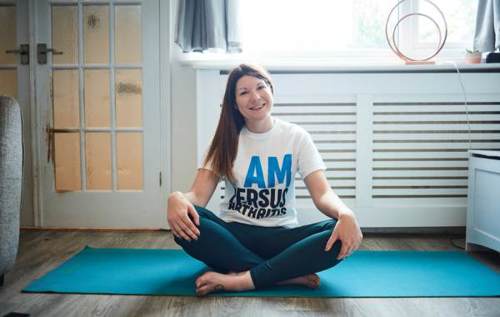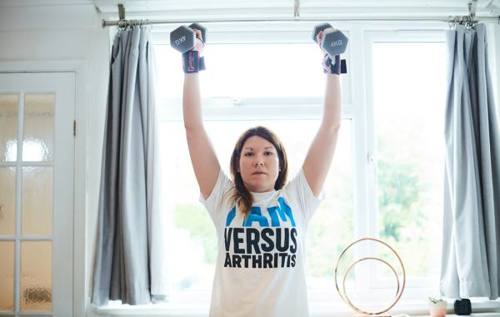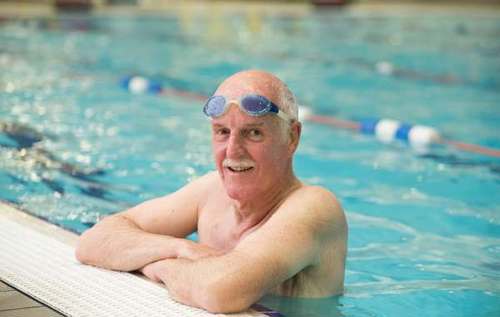Ask the expert: I have arthritis, should I exercise?
30 April 2024
Some people with arthritis are worried about exercising and believe it could make their arthritis or musculoskeletal condition worse.
If you have questions about whether you should exercise or if it could impact your condition, read on.
We asked Dr Benjamin Ellis, consultant rheumatologist and senior clinical policy advisor at Versus Arthritis to answer your frequently asked questions about exercising.
He acknowledges that there are many reasons why some people with arthritis may avoid exercise.
But he believes that the most important thing you can do is to find an exercise that works for you, listen to your body and be gentle with yourself.
Sign up to the Let's Move Newsletter for more exercise tips
I don’t know how to take the first step to start being active. Can you help?
 Being active is one of the best things you can do to help manage your arthritis symptoms.
Being active is one of the best things you can do to help manage your arthritis symptoms.
Look for something you enjoy or an exercise you’ve enjoyed in the past which you’d like to get back into.
Think about whether you prefer to exercise on your own or with others. Do you want to exercise at home, or would you prefer to get out of the house?
Are you looking for something slow and calm like Pilates or yoga, or an activity with music and dance, like Zumba?
If you haven’t exercised for a while, start slowly and build up. If you know you find specific movements painful, for example, kneeling on the floor. Look for alternatives like swimming, or speak to the instructor if you are doing a class – they may be able to suggest different movements for you.
Exercise doesn’t always make everything better. But it will make you stronger and help you do more of the things you enjoy.
You might surprise yourself and find a new hobby or make new friends.
Find out our top tips for getting started with exercise
How do I know what is good pain vs bad pain?
People really worry about this, and it’s a fair question.
The most important thing is to listen to your body. By starting slowly and building up, you’ll learn what’s right for you. And as you become stronger from doing exercise regularly, your body will be able to handle more.
If you experience a sharp pain while you’re exercising, take a break or stop what you’re doing. If the pain persists, you should get some advice from a health professional, such as a doctor or physiotherapist.
"But not all pain is bad. If you’re pushing your body when you exercise, it’s normal to have some discomfort the day after. Even athletes can feel sore the day after a workout!"
But if you’re in wiped out and in agony the day after, then probably you’re doing a bit much a bit too soon. So next time you exercise, go easier on yourself – maybe a shorter session, and less intense.
I find it hard to stay motivated. What will give me a boost?

The first thing is not to feel bad about it. The key to exercising regularly is probably to make it a habit, part of your daily routine. So, if you’re finding it hard, cut yourself some slack and don’t despair!
For some people, it can help to plan ahead and put your exercise plan in your diary or stick it up on the fridge and tick things off as you do them. Some people find it works best to make plans with others – going for a walk with someone or taking part in a class with others.
It’s such a personal thing – only you know why you want to exercise. Maybe you want to be more independent, to have more energy, or to feel better about your body?
And you could look again at what exercise you’ve chosen. Just because the first thing you tried isn’t working for you doesn’t mean that there isn’t something out there that’s just right for you!
If the route to being more physically active feels a bit bumpy, hang in there – you’ll get there in the end!
Will exercise help me feel better?
Exercise will help most people with arthritis feel better.
For some people this means having less pain and stiffness. For others it means feeling fitter, having more energy, and better sleep.
If you’re exercising with others, it might be that exercise helps build new friendships and create community that you enjoy. Many people with arthritis and chronic pain also have low mood, or anxiety, and physical activity can really help with that too.
Remember as well, that regular exercise can also help your health in the future as it can reduce the risk of diabetes, heart disease and dementia.
All these things are important, but only you’ll know which of these is most important to you.
Learn how staying active can reduce your pain and the symptoms of your condition
I’ve been told not to exercise by members of my family, I’m not sure what I should do.
I’m sure that your family only want what’s best for you. So, perhaps you need to explore their concerns with them?
If they’re worried it could be risky to exercise, maybe you could spend time together looking at the Versus Arthritis website, which is a great source of trustworthy advice.
If you have a lot of family commitments, it can be hard to take time away from family to exercise too. But in the long run, being stronger and fitter will make it easier to look after yourself and your family.
Whatever the reason for their concerns, it’s much better to have your family’s support. Perhaps they can come on the journey with you – and maybe you can sometimes even exercise together!
What else might help?
 There are a few issues that often come up in clinic when I discuss exercise with people with arthritis. It can make people feel self-conscious about their bodies, and about exercising in front of other people.
There are a few issues that often come up in clinic when I discuss exercise with people with arthritis. It can make people feel self-conscious about their bodies, and about exercising in front of other people.
Swimming in particular can worry people who don’t like the idea of walking around in swimwear. The reality is that most pools, gyms and classes are full of ordinary people with a whole mix of body shapes and sizes.
It shouldn’t be too hard to find clothes you’re comfortable exercising in and you don’t need to spend a lot of money. You can even get long sleeved things to swim in, if you want to. If you are unsure whether your local leisure centre, gym or pool will be accessible for you, then before you go you can get in touch to ask about the facilities.
For example, checking if the pool has railings, ramps and steps, or whether there’s a grab rail in the shower.
Lots of people worry about the cost of using a gym or pool or attending classes. It’s worth checking out whether your local NHS or Local Authority provides any low-cost exercise opportunities.
There are plenty of exercise options that cost little or nothing, though. If you’re lucky enough to have countryside or safe outdoor space near you, then you could explore walking or cycling.
If you’re pressed for time due to childcare or work, then see if you can build in exercise as part of your routine. Can you go for a walk at lunchtime or do a yoga session before work? Can you park the car a little further away, or get off the bus a stop early, so that you can build a walk into your journeys?
"Think about when in your day you’ll have the most energy and when your symptoms are most manageable and try to build in the exercise then. It can be really hard to exercise in the evening, after a long day of activities."
In summary, there are lots of things that can make it hard to exercise, but there are big reasons why you might want to find a way to do it, if you have arthritis. Listen to your body, start slowly and build up, commit to a regular plan and go easy on yourself if at first it seems hard. It will almost certainly be worth it.
Useful resources
If you would like to find out more ways to stay active, why not try Let’s Move with Leon?
This 12-week programme offers 30-minute movement sessions specially designed for people living with arthritis.
You can also join our Let’s Move Facebook group, a space where people share their experience of staying active when living with arthritis.
Or you can sign up to our Let’s Move newsletter to receive exercise advice and tips straight to your inbox.
We’re here whenever you need us
- If you would like to talk to someone, you can call our free helpline on 0800 5200 520 (Monday to Friday, 9am to 6pm)
- Join our online community
- Stay in touch and follow us on Twitter, Facebook and Instagram.